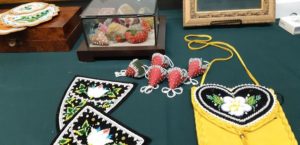Beadwork revival a life’s journey for artist Naomi Smith

By Brian Wright-McLeod
TORONTO— Indigenous artisan, educator and proprietor of Black Tulip Designs, Naomi Smith, from the Mississaugas of the Credit, is actively reviving a centuries-old beadwork technique to the highest degree.
Working exclusively in the woodland saddle-style beadwork method (a raised three-dimensional form), Smith executes her treasured creations with the finesse and dedication of a true master.
Her inspiration is derived from a technique that originated in 1830 which employs raised floral designs and patterns created in moose hair and quills. She sources original materials such as antique beads to create her work that honours the past with a preservation aspect for the future.
To attest to her accomplished efforts, she was a featured First Nation artisan at the 2010 Vancouver Winter Olympics, and a 2018 Artist in Residence at the Schneider Haus Historical Site.
More recently, she was one of 30 artisans from across North America selected for the annual exhibit at the Smithsonian’s National Museum of the American Indian Gustave Heye Center in New York City.
“This is my seventh year at this juried exhibit,” she said. “Getting through the application process is a monumental task that’s based on the quality and merit of the work.”
The result of years of experience, her talents and knowledge are derived from a life-long journey.
“I’ve been doing beadwork since I was seven-years-old,” she said. “So, it’s been more than 30 years that I’ve been doing this.”
Smith also began collecting antique beadwork over a decade ago in order to learn and preserve the style.
“I found a bag from the early 1900s that originated from my reserve,” she said. “It’s all getting harder to find.”
In addition to locating materials and items from the internet sites, antique shows are ideal for sourcing original materials and for networking opportunities. Smith also sees herself as a custodian and a Knowledge Keeper.
“With 20 years of research, I have come full circle,” she said. “If this style is disappearing then it’s important to revive it within the communities as I continue to work with the Six Nations revitalization project with a Seneca Elder in reestablishing this style of beadwork.”
The importance of her task was encouraged at an early age.
“My mom said, before she passed, that I should share the knowledge so it doesn’t fade away,” she explained.

She continues to teach beading classes, particularly with the youth who are realizing the value of the craft.
“They recognize the cultural value and want to study the traditional forms and patterns, and enjoy using the materials,” she said.
Sharing her talents, she also loans her creations to museums with an original piece acquired by the Boston Museum of Fine Art.
A pinnacle of her current achievements was designing and creating Santee Smith’s chancellor outfit for McMaster University. It was possibly the most challenging project that included a traditionally patterned cape, collar, cuffs and cap in the Haudenosaunee style.
“It was a project that I created for someone else,” she said. “So the timeline was a pressing issue that kept me going with little breathing space.”
Needless to say, the result was a stunning success.
With a sense of determination, care and attention to detail, her work ethic is one of patience and pride.
“I always want to have time to do the work and I never know how long it will take,” she said. “I don’t take short cuts and I want the design to look exactly how I want it to look. That’s where I feel a sense of fulfillment as artists; it’s what we’re meant to do.”


